Historic Preservation at the University of Arizona
The University of Arizona is committed to the stewardship of cultural and architectural resources on the main campus and other properties throughout Arizona and consults with the State Historic Preservation Office on projects and preservation issues to ensure that our heritage resources are managed and preserved for the future.
The University oversees four National Register-listed Historic Districts in Southern Arizona which feature buildings, structures, historic landscapes, landscape features, and cultural resources. The main campus has also been designated a Campus Arboretum and showcases a world-class collection of desert-adapted plants including a number of Heritage Trees and Great Trees of Arizona.
Campus Historic District
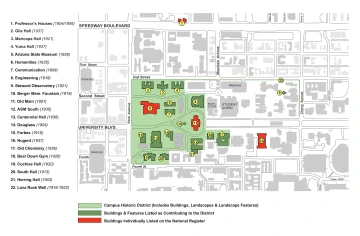
Map of University of Arizona historic district and buildings. Click to enlarge.
The 33-acre Campus Historic District was created in 1986, recognizing the significance of the campus historic core. The district is listed on the National Register of Historic Places and showcases buildings and landscapes dating from 1891 through 1937.
The verdant landscapes of the Historic District have been a favorite place for generations of students, staff, and the Tucson community. Features within the landscape, such as the lava rock wall, the Main Gate, Berger Memorial Fountain and the fish pond are all part of the historic fabric.
Buildings in the Historic District display a record of architectural styles ranging from Territorial Queen Anne to Classical Revival, Renaissance Revival, and Spanish and Romanesque Revival. The use of red brick, exquisite detailing, and fine craftsmanship are hallmarks of these buildings. Seventeen historic buildings are located within the boundaries of the district and five are located elsewhere within the campus boundary.
The Historic Preservation Plan was produced as a companion document to the Campus Master Plan and focuses on the history, management, preservation and maintenance of campus historic resources.
National Register of Historic Places
Click on the headers below to expand each section.
Old Main is the University of Arizona's oldest building and originally housed all functions of the University, from classrooms and laboratories to offices and sleeping quarters. Stylistically the building utilizes a territorial vernacular with a few European adaptations such as the French mansard roof. The building reveals a conscious attempt to relate to conditions of the Sonoran Desert with its broad, elevated and encircling veranda, high roof forms, partially recessed ground floor and large windows.
The building was ingeniously designed to accommodate repeated changes in use over time, and did so without losing its original character. In 1972 Old Main became the first campus building listed on the National Register of Historic Places, and in 2014 underwent an award-winning, comprehensive rehabilitation.
The 2011 Old Main Preservation Plan is a document containing valuable historical information about the building and summarizes the specific needs addressed in the 2014 renovation.
| Construction Year | 1887 |
|---|---|
| Style | Territorial Queen Anne |
| Architect | James Miller Creighton |
| Listed on National Register | 1972 |
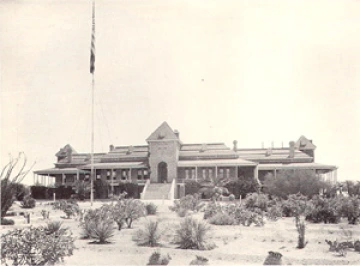
Old Main c. 1902
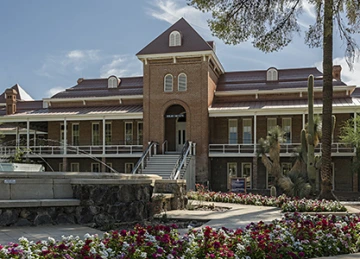
Old Main 2014
This building was designed and used as the university library until a new facility was constructed east of Bear Down Gym in 1976. Now housing the Arizona State Museum, the building is arguably the most impressive structure facing the UA mall. Its symmetrical Italianate facade, large two-story arched windows, and red tile roof present a dignified presence just inside the University Main Gate. The building's fine brickwork and terra cotta detailing, as well as its charming interior spaces, are worthy of closer inspection. The main lobby and the second floor reading room with its 30-foot ceilings are particularly notable.
| Construction Year | 1924-27 |
|---|---|
| Style | Renaissance Revival |
| Architect | Lyman and Place |
| Listed on National Register | 1979 |
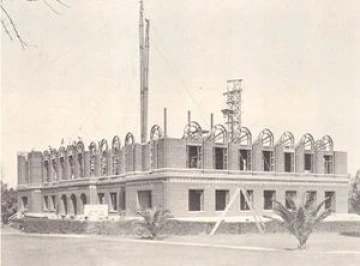
Arizona State Museum c. 1924

Arizona State Museum 2004
Constructed in 1926 to replace Herring Hall, the original gymnasium, Bear Down Gym is a two story brick structure noted for its curved roof, large semicircular terra cotta entrance and deeply recessed entry with copper-clad window frames. The building is topped with a slightly projecting cornice that includes terra cotta detailing. The exposed bow-truss roofing system is a notable interior feature.
Bear Down gym was the last building on campus to exhibit references to classicism.
Originally, the main level provided basketball courts and room for gymnastics, while the lower level contained locker rooms, offices, and space for the Department of Military Science and Tactics. At one time, the building seated about 3,600 spectators and was used not only for sports, but for dances and annual registration activities.
During World War II, the building was used to house up to 500 people at a time who were enrolled in the Naval Indoctrination School, which had restored Old Main for use by the military.
Bear Down underwent an extensive adaptive reuse renovation in 2021, but the building today retains much of its original character. Bear Down is now the centerpiece of the four building Student Success District which provides a cohesive ecosystem that supports students.
| Construction Year | 1926 |
|---|---|
| Style | Classical Revival |
| Architect | Roy Place |
| Listed on National Register | 1990 |
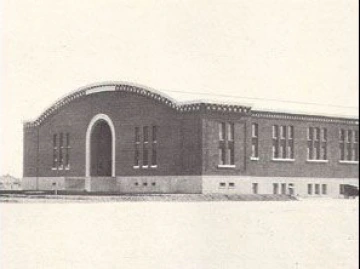
Bear Down Gym c. 1927
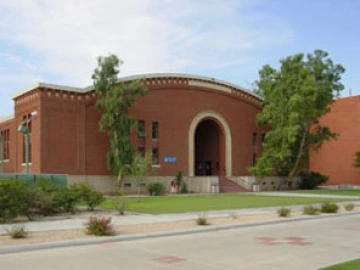
Bear Down Gym 2005
Professor George P. Smith was a Vermont native who came to The University of Arizona in 1900, and during the next fifty-five years became a recognized authority on all aspects of water supplies in Arizona. He was active in the municipal affairs of Tucson and contributed much to the early planning of the city. The house, located at 1195 E. Speedway Boulevard, was the first personal home in Tucson built north of Speedway Boulevard. The adjacent Cannon-Douglas house was the second, and together they are the only remaining early professors' houses adjacent to the University. The house was listed on the National Register in 1982 and remained in the family until it was given to the UA in 1989.
| Construction Year | 1904 |
|---|---|
| Style | Territorial Vernacular |
| Architect | George P. Smith |
| Listed on National Register | 1982 |
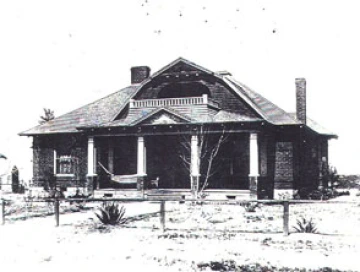
Smith House c. 1904
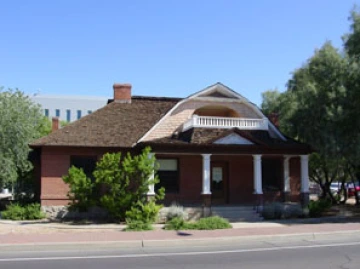
Smith House 2008
Professor George P. Smith was a Vermont native who came to The University of Arizona in 1900, and during the next fifty-five years became a recognized authority on all aspects of water supplies in Arizona. He was active in the municipal affairs of Tucson and contributed much to the early planning of the city. The house, located at 1195 E. Speedway Boulevard, was the first personal home in Tucson built north of Speedway Boulevard. The adjacent Cannon-Douglas house was the second, and together they are the only remaining early professors' houses adjacent to the University. The house was listed on the National Register in 1982 and remained in the family until it was given to the UA in 1989.
| Construction Year | 1906 |
|---|---|
| Style | Territorial Vernacular |
| Architect | George P. Smith |
| Listed on National Register | 1982 |
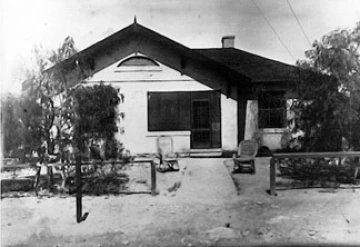
Cannon-Douglass House c. unknown
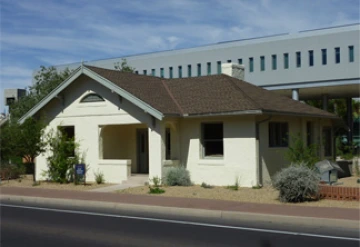
Cannon-Douglass House 2011
Tumamoc Hill is a uniquely situated cultural and archaeological treasure west of Downtown Tucson that was occupied for more than 2,000 years. Massive retaining walls and terraces, remnant foundations of more than 160 prehistoric structures, petroglyphs, prehistoric gardens and other cultural features are found on the Hill.
The Desert Botanical Laboratory is a world-renowned research center established in 1903 by the Carnegie Institution for the study of desert ecosystems. The Laboratory site includes a collection of unique buildings dating from 1903 to 1940, and some of the longest continually-studied botanical plots on earth.
The Carnegie Institution managed the Desert Laboratory until 1940, when ownership was transferred to the National Forest service. The Laboratory was purchased by the University of Arizona in 1960, designated a National Historic Landmark in 1965 and was placed on the National Register of Historic Places in 1966. The Laboratory and Tumamoc Hill were together designated a National Environmental Study Area in 1976 and a State Scientific and Educational Natural Area in 1981.
The 2006 Tumamoc Hill Management Plan provides extensive information on the archaeology, research, facilities and history of Tumamoc Hill.
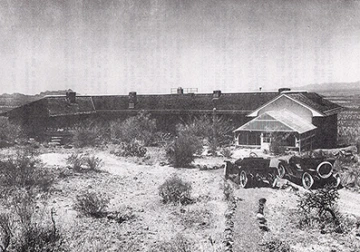
Desert Laboratory, 1911
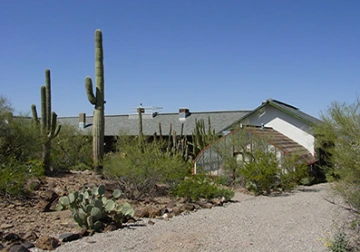
Desert Laboratory, 2005
The Hatch Act of 1887 and the Smith-Lever Act of 1914 enabled the University, as a land-grant institution, to establish an experiment station for agricultural research and student instruction. The Center, located on Campbell Avenue, was established in 1909 and continues to evolve modern laboratory and field-based research, instruction and outreach needed for the land-grant mission of the University.
The 13-acre Campus Agricultural Center Historic District incorporates a collection of buildings, structures, and a site unified by their shared association with the historical scientific and educational study of agriculture and animal husbandry at the University of Arizona.
The architecture of the district includes Vernacular, Territorial, and Mission Revival architectural styles dating from 1910 - 1936. The 1930s-era Mission Revival buildings were designed by the office of local architect and former Tucson Mayor Henry O. Jaastad and his chief designer, Annie Graham Rockfellow.
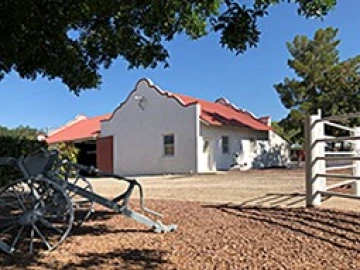
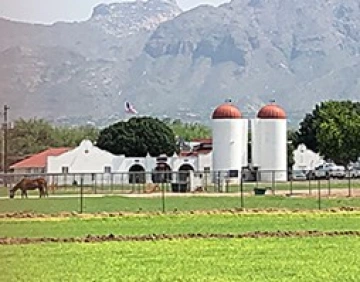
The School of Anthropology (SOA) oversees the 13-acre University Indian Ruin Archaeological Research District, listed on the National Register of Historic Places. The district contains two separate components: 1) historical period Civilian Conservation Corps (CCC) - constructed adobe buildings, and 2) the core of an Hohokam-era archaeological site.
The site has been the location for a number of archaeological field schools since the 1940s. The CCC-era adobe buildings include a residence, a laboratory facility and outdoor space for educational activities and socializing.
In 1930, Mrs. Dorothy Knipe donated the initial six acres of the property to the University of Arizona, with the stipulation that the site be used to serve the University’s educational goals. The current mission for UIR use has three components: preservation of the historical period buildings and archaeological site; training of students; and public education and outreach.
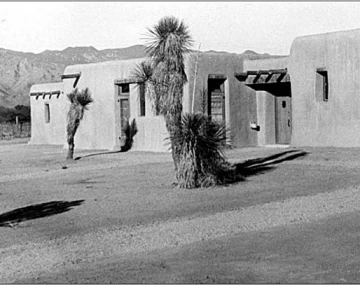
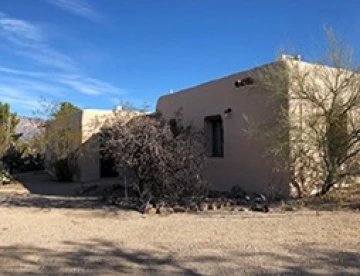
Originally known as the El Zaribah Shrine Auditorium, this building is located on the Capitol Mall in Phoenix at 1502 West Washington Street. The building was designed by the noted Phoenix architectural firm of Lescher and Mahoney and constructed in 1921. It is individually listed on the National Register of Historic Places.
The building was renovated for use as the Mining and Mineral Museum in the early 1990s but was vacated in 2011. Plans are currently being developed in consultation with the State Historic Preservation Office for rehabilitation and adaptive reuse as the Arizona Mining, Mineral and Natural Resources Education Museum.
The museum will undergo renewal under the University of Arizona Office of Research, Innovation and Impact, and will showcase the historical, cultural, economic, and social contributions of the mining, mineral, timber, livestock and agricultural industries of Arizona through education, research and outreach.
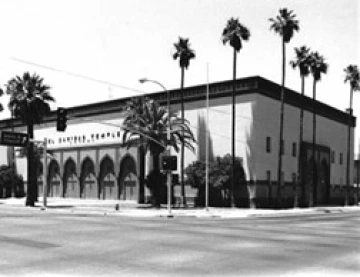
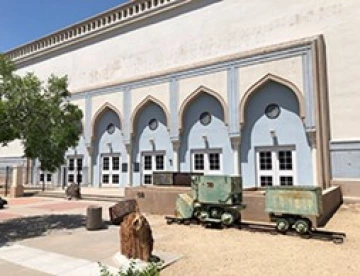
Historic District Buildings
Click on the headers below to expand each section.
Herring Hall is the second-oldest existing building on campus. Originally constructed as the Men's Gymnasium, it was also often used for dances and other social events. Over the years the building has housed a number of diverse programs, including Drama, Journalism, the Radio & TV Bureau, and Landscape Architecture.
The building was made possible by a gift of $5,000 from Dr. James Douglass and his associates from the Copper Queen Mining Company. It was named for Col. William Herring, territorial lawyer and legal counsel for the Phelps Dodge Corporation.
Herring Hall has undergone a complete restoration for use by the College of Agriculture and Life Sciences.
| Construction Year | 1903 |
|---|---|
| Style | Classic Revival |
| Architect | D. H. Holmes |
| Listed on National Register | 1986 |
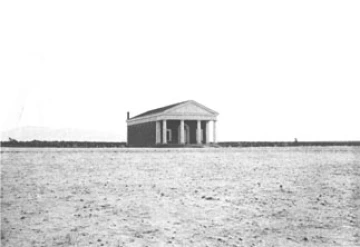
Herring Hall c. 1902
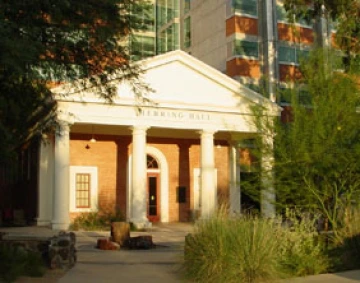
Herring Hall 2006
Science Hall (now known as the Communications building) is a 3-story brick building that allowed the relocation of laboratories away from the ever-present fire dangers in Old Main. In 1909 it was the largest building on campus and housed physics, chemistry, and biology labs. The top floor was designed to accommodate the campus’ fledgling observatory and an eight-inch telescope on loan from Harvard University.
This building has an elegant classical entry, symmetrical composition, and tiled hip roof with overhanging eaves. The third story has a stucco finish with diamond-shaped brick details similar to the Douglass Building directly across the street. The two complementary buildings flanked the entry drive to Old Main and helped define the symmetry of the early campus plan.
| Construction Year | 1909 |
|---|---|
| Style | Vernacular Classical |
| Architect | D. H. and J. H. Holmes |
| Listed on National Register | 1986 |
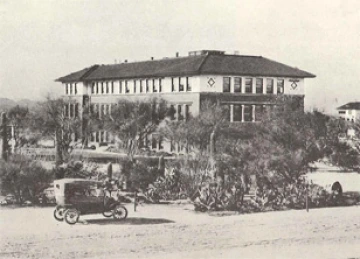
Communications c. 1914
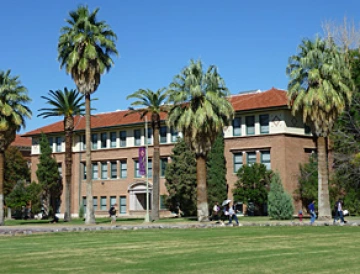
Communications 2011
The College of Agriculture was the first academic unit of the University of Arizona and in 1915, the impressive new Agriculture Hall (now Forbes) was the pride of the College and housed its six newly-created departments. The large building included room for growth, and for several years the Office of the President and the Arizona State Museum were located in the building.
The San Diego Architects Lyman & Bristow were selected in a competition, designing in the Classical Revival Style popular at the time. The building displays a recessed portico with unfluted Ionic columns, elaborately detailed entrance doorways, and unique herringbone brickwork on the façade spandrel panels. The roof is mission tile with deep overhanging eaves.
| Construction Year | 1915 |
|---|---|
| Style | Classical Revival |
| Architect | Lyman & Bristow |
| Listed on National Register | 1986 |
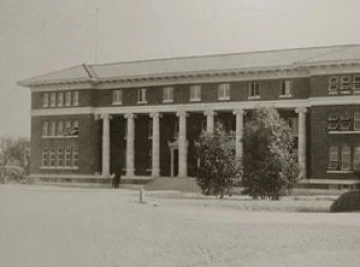
Forbes c. 1915
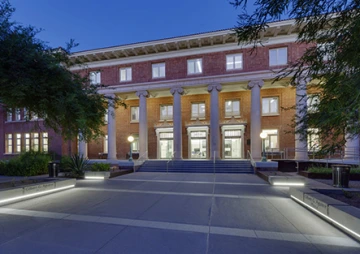
Forbes 2015
Cochise residence hall was constructed along South Campus Drive as a men’s dormitory and houses 181 students. During the campus’ early years, the men’s residences were located south of Old Main and the women’s to the north. Today, the hall is co-ed and includes three wings dedicated to ROTC students.Cochise residence hall was constructed along South Campus Drive as a men’s dormitory and houses 181 students. During the campus’ early years, the men’s residences were located south of Old Main and the women’s to the north. Today, the hall is co-ed and includes three wings dedicated to ROTC students.
The building was designed in the Classical Revival Style and features an impressive six column Corinthian porch, elevated atop broad steps. A full entablature and balustrade is supported by the columns which are two stories tall and have finely foliated capitals characteristic of the Corinthian Order. Inside the portico, the building entrance displays fine terra cotta detailing with appropriate classical forms.
| Construction Year | 1920-21 |
|---|---|
| Style | Classical Revival |
| Architect | Lyman & Place |
| Listed on National Register | 1986 |

Cochise c. 1940
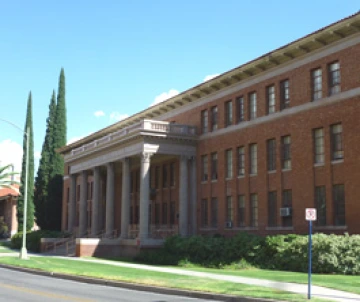
Cochise 2011
The idea for an astronomical observatory on campus was championed by Andrew Ellicott Douglass, who established and operated the Lowell Observatory in Flagstaff before coming to the UA in 1906. He became the first Professor of Astronomy at UA and later the Director of Steward Observatory. The building was made possible by a $60,000 gift from Mrs. Lavinia Steward in memory of her late husband, Henry. Contracts were issued in 1917 and after being delayed by WWI, the building was completed in 1923.
The small octagonal building displays classical influences in its implied pilasters, entablature, and entrance arch, and its white glazed terra cotta brick helped to mitigate the impact of desert heat on the scientific instruments inside. This building is the only historic building on campus not constructed of red brick.
The building originally housed a 36" telescope, and was the first professional telescope to have all of its parts manufactured in the U.S. The 36" scope was removed in the 1960s and a smaller, 20" Cassegrain telescope was installed for student use.
| Construction Year | 1917-23 |
|---|---|
| Style | Classical Revival |
| Architect | Lyman & Place |
| Listed on National Register | 1986 |
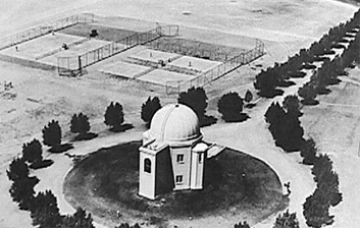
Steward Observatory c. 1918
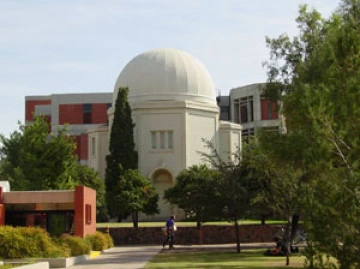
Steward Observatory 2006
The 1935 Arizona State Museum building provided a much-needed permanent home for the University’s growing collection of archaeological artifacts. The lower levels were designed for conservation and storage, with display areas, classrooms, and offices on the upper floors. It served as a museum for decades but eventually proved inadequate for modern conservation and display needs. The building is currently used for artifact storage and offices.
The building displays both Spanish and Italian Romanesque Revival tendencies and features heavy masonry walls, articulated semicircular arches, and unique octagonal columns with basket weave capitals at the building entry. The spandrel panels exhibit a decorative “pueblo deco” tile design similar to those seen on the Humanities building.
| Construction Year | 1935 |
|---|---|
| Style | Italian & Spanish Romanesque Revival |
| Architect | Roy Place |
| Listed on National Register | 1986 |
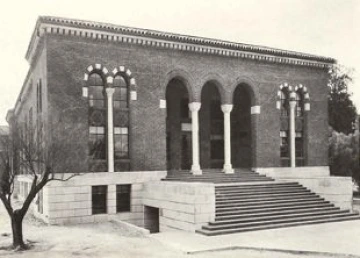
Arizona State Museum South c 1939
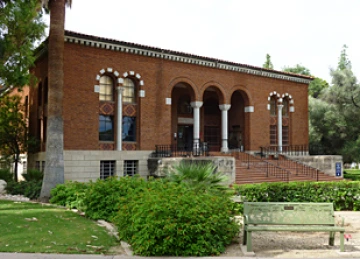
Arizona State Museum South 2010
The Chemistry-Physics department moved out of Science Hall (now Communications), where it had been since 1914, into a new spacious building east of Old Main. This structure had plain and simple interiors but contained much-needed modern laboratory equipment and room to grow.
The three-story brick building with red tile roof is designed in the Italian Romanesque Revival Style. The main façade features two main entries of contrasting classical design which penetrated the base rather than set atop it. The central portion of the building has groupings of arches with tall, slender Corinthian columns. The protruding end pavilions feature brick piers with arches and elegant “pueblo deco” spandrel panels.
| Construction Year | 1936 |
|---|---|
| Style | Italian Romanesque Revival |
| Architect | Roy Place |
| Listed on National Register | 1986 |
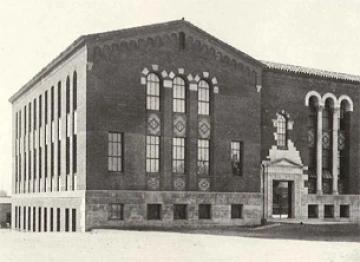
Chemistry c. 1936
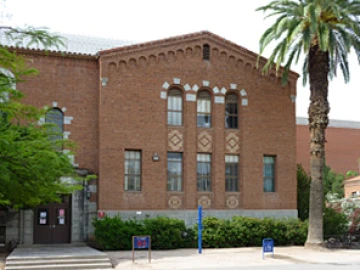
Chemistry 2010
Yuma Hall was built on the site of East Cottage, an 1892 Victorian structure that over the years had housed female students, faculty members and finally the school of music. One of the last PWA projects on campus, Yuma was similar in plan and form to Gila Hall but was designed in the Italian Romanesque style.
The three-story brick building has three protruding pavilions displaying Italianate ornamentation, and a central arched entrance.
| Construction Year | 1937 |
|---|---|
| Style | Romanesque Revival |
| Architect | Roy Place |
| Listed on National Register | 1986 |
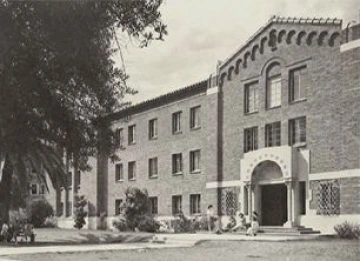
Yuma Hall c. 1940
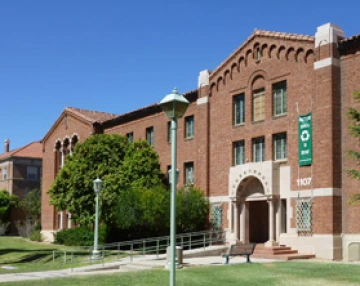
Yuma Hall 2012
The 4,700-foot long rock wall was constructed along Park Avenue and Second Street over a 20-year period. The wall averages four feet in height and displays exceptional masonry skill. At the Main Gate, elegant curves punctuated by tall piers rise up to support a pair of iron gates which were a gift from the City of Prescott. With few exceptions, the wall retains its original integrity and continues to define the Campus Historic District.
The lava rock wall is listed as a contributing landscape element to the National Historic District.
| Construction Year | 1916-38 |
|---|---|
| Style | N/A |
| Architect | N/A |
| Listed on National Register | 1986 |
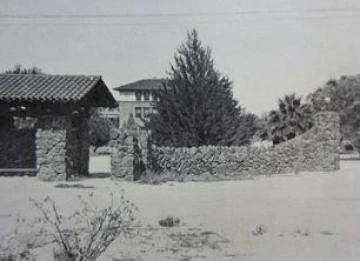
Lava Rock Wall c. 1919
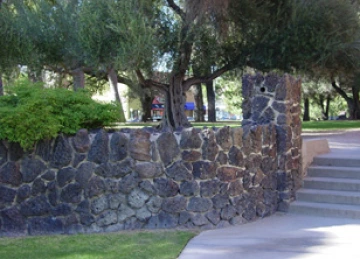
Lava Rock Wall 2011
The Douglass Building was built in 1904 as the University Library and Museum. The building housed the Law School from 1929-1959 followed by the Psychology Department until 1979. Currently the Departments of Linguistics and Latin American Studies share this facility. The building was named after A.E. Douglass, acting president of the University in 1910, noted astronomer, and a leader in establishing the Laboratory of Tree-Ring Research and Steward Observatory.
The building exhibits classical symmetry and rhythm and contains visual references in the entrance composition, regular belt courses, and suggestions of capitals and bases in window mullions. The building also reflects horizontal emphasis characteristic of midwestern Prairie School architecture. The facades are notable for their window groupings, the juxtaposition of various motifs, excellence in brickwork and patterning of glazed header bricks.
| Construction Year | 1904 |
|---|---|
| Style | Classical Revival |
| Architect | Russell, Moran & Garden |
| Listed on National Register | 1986 |
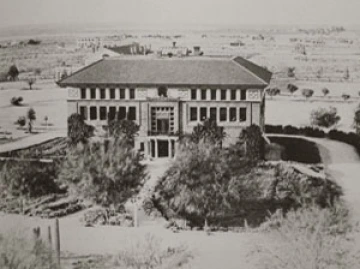
Douglass Bldg c. 1911
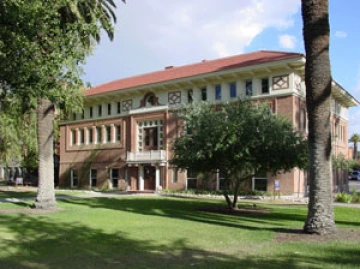
Douglass Bldg 2004
Originally known as Arizona Hall, the men’s dormitory was named in honor of Arizona’s admission into statehood in 1912. The building is currently used as the home of the UA ROTC program. A desirable feature of the building was its U-shaped plan with south-facing sleeping porches that were warmed by the sun in winter and shaded by deciduous trees in summer.
The red brick building displays a simpler expression of the Classical Revival style, utilizing classical forms and elements without the ornamentation seen on nearby campus buildings. Features include an entry portico with plain brick piers with stucco caps, less prominent entry stair, and hipped tile roof with simple wooden eaves.
| Construction Year | 1913 |
|---|---|
| Style | Classical Revival |
| Architect | David Holmes |
| Listed on National Register | 1986 |
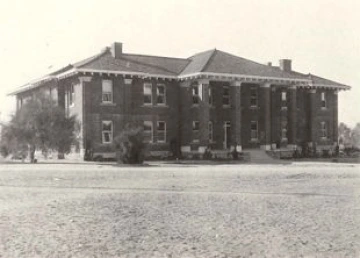
South Hall c. 1913
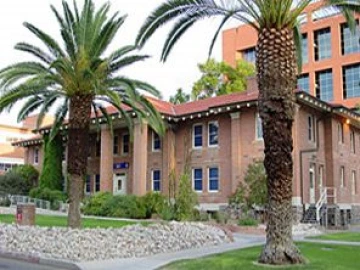
South Hall 2006
The School of Mines was housed in Old Main from opening day in 1891 until construction of the Mines and Engineering building in 1918. Located directly north of Old Main, the building is a companion to the 1915 Agriculture building and the two impressive structures flank Old Main in a symmetrical composition. In addition to offices and classrooms, the three-story concrete and brick building included a mining laboratory, mechanical engineering laboratory, and a geological museum.
The building’s most notable features include an impressive recessed portico with eight Doric columns and the deemphasized roofline. The finely detailed portico is modeled after the Parthenon on the Athenian Acropolis and its entablature wraps the entire building. The simplicity of detailing, horizontal lines and rhythm of openings epitomizes the Classical Revival Style.
| Construction Year | 1918 |
|---|---|
| Style | Classical Revival |
| Architect | John B. Lyman |
| Listed on National Register | 1986 |
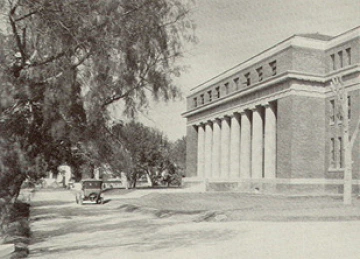
Engineering c. 1918
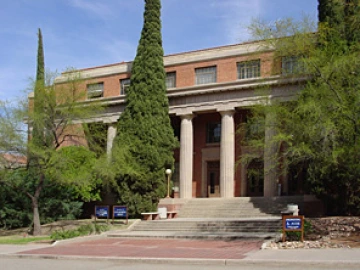
Engineering 2004
Growing enrollment in the early part of the last century created a need for a large women’s dormitory. A design competition awarded the Phoenix firm of Lescher & Kibby with a $500 prize for their design, but afterward the firm of Lyman and Place was given the construction contract for the building. The women are assigned to double rooms and the building’s original sleeping porches are still used today.
The Classical Revival design features a two-story entry porch with four pairs of plain columns topped with stylized Corinthian capitals. Horizontal bands at the cornice level of the porch and below the roofline wrap the entire building. The first floor features a series of arched openings which originally contained French doors.
| Construction Year | 1921 |
|---|---|
| Style | Classical Revival |
| Architect | Lyman & Place |
| Listed on National Register | 1986 |
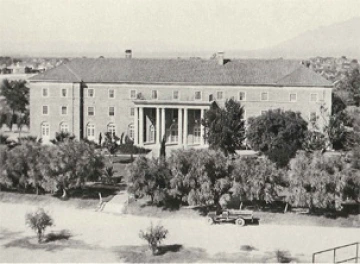
Maricopa Hall c. 1930
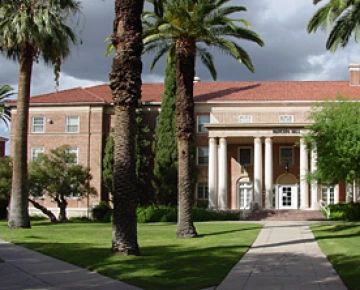
Maricopa Hall 2006
In 1934, President Homer Shantz obtained Public Works Administration (PWA) funds from the Federal Government to initiate a seven-building capital program for the campus. All of these buildings would be designed by Roy Place in the "Lombard Romanesque style with variations."
The Humanities Building (now the Center for English as a Second Language) provided 18 badly-needed classrooms, which included two large auditorium-type lecture rooms. While the outside of the building was fairly decorative, the interiors were simple and no-nonsense, with concrete floors, plain walls, and no elevator.
The building exhibits Italian Romanesque detailing, including two-story recessed window openings topped with semicircular arches articulated with terra cotta voussoirs. Spandrel panels between floors contain glazed earthtone terra cotta panels with 'Pueblo Deco' tile patterns. Beneath the red-tile roof, the building facades display a combination of expressions, including a corbeled arch cornice and a frieze of alternating terra cotta and brick panels.
| Construction Year | 1935 |
|---|---|
| Style | Classical Revival |
| Architect | Russell, Moran & Garden |
| Listed on National Register | 1986 |
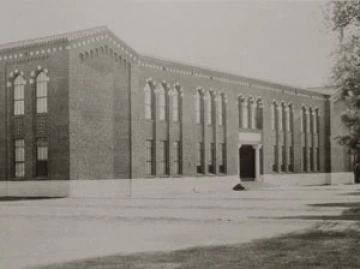
Humanities Bldg c. 1935

Humanities Bldg 2004
In the early 1930s there was considerable controversy over plans for the new Auditorium, including the optimal location and whether it would ever fill to its capacity of 3,000. The building is still in full-time use for shows and concerts and at times is used as a large classroom. The Auditorium was renamed in 1985 in honor of the UA’s Centennial, and underwent a complete renovation. Additions included a new fly space, exit lobbies to the sides, and an expanded main lobby that enclosed the entry porch.
The building’s most notable features include the five, deeply-recessed arched openings, fine brick detailing including V-shaped dentils at the cornice, and red tile roof.
| Construction Year | 1936 |
|---|---|
| Style | Romanesque Revival |
| Architect | Roy Place |
| Listed on National Register | 1986 |
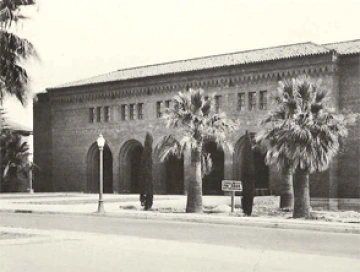
Centennial Hall c. 1936
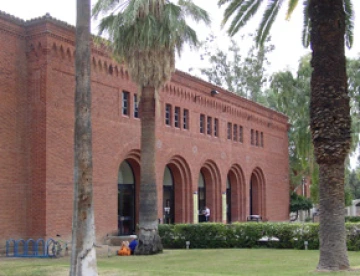
Centennial Hall 2005
Gila Hall replaced the president’s house on North Campus Drive, which had stood on the site since 1893. Completed in the fall of 1937, Gila was the last major UA building constructed with Public Works Administration (PWA) funds.
The three-story brick building with red tile roof is designed with classical influences but is restrained in its ornamentation. Fine brick detailing is evident in a horizontal course wrapping the building between the second and third floors, and small towers on the east and west ends display creative brick patterning and fine craftsmanship. A classical cornice with shallow overhang wraps the top of the building. The charming original balcony seen in the left photo has unfortunately been removed.
| Construction Year | 1937 |
|---|---|
| Style | Classical Influence |
| Architect | Roy Place |
| Listed on National Register | 1986 |
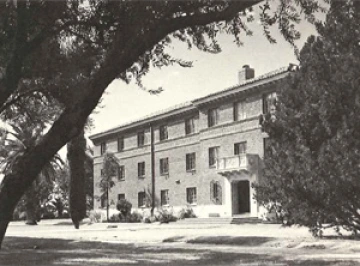
Gila Hall c. 1940
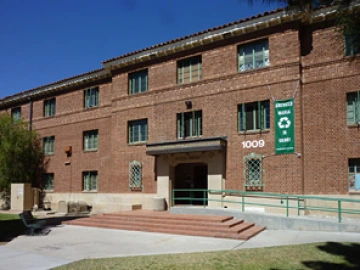
Gila Hall 2012
The Administration Building (now Nugent Building) is a rectangular three-story brick building to which wings were added to the east and west in 1953. In its earlier years, this building consolidated administrative offices including the President, Registrar and others, and included a formal Regents meeting room.
The most notable feature of the building is the recessed entry with cast concrete trim, classical balcony, and large arched window. Other features include a red tile roof, terra cotta detailing, and glazed tile “pueblo deco” spandrel panels.
| Construction Year | 1937 |
|---|---|
| Style | Italian Romanesque Revival |
| Architect | Roy Place |
| Listed on National Register | 1986 |
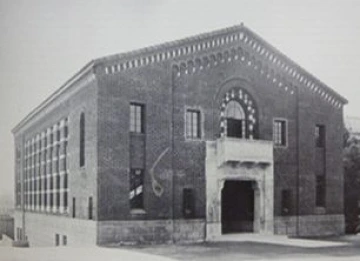
Nugent c. 1937
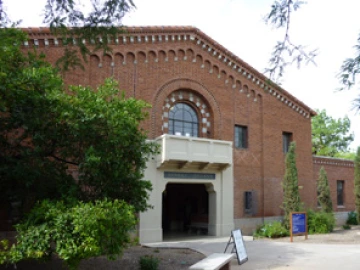
Nugent 2006
Located immediately west of Old Main, the fountain was built to memorialize those UA students who lost their lives in World War I. The fountain was a gift of Alexander Berger, uncle of one of those memorialized, and was dedicated on January 31, 1920 by General John J. Pershing.
The octagonal fountain is constructed of reinforced concrete with accents of black volcanic rock of the type used for other campus landscape features during this period.
| Construction Year | 1919 |
|---|---|
| Style | N/A |
| Architect | Lyman & Place |
| Listed on National Register | 1986 |
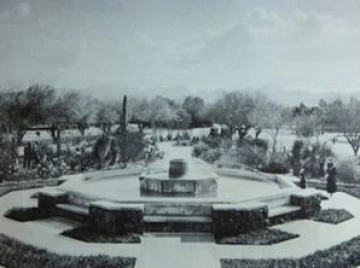
Berger Memorial Fountain c. 1919
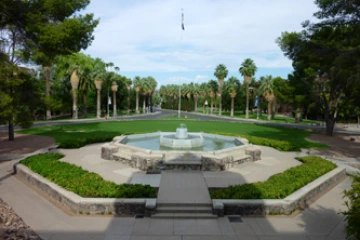
Berger Memorial Fountain 2012
Policy and Contact
For information and inquiries about Historic Preservation at the University of Arizona, contact:
Jessica A. Bassi
University of Arizona Historic Preservation Coordinator
jbassi@arizona.edu
Ph: 520-400-3493

